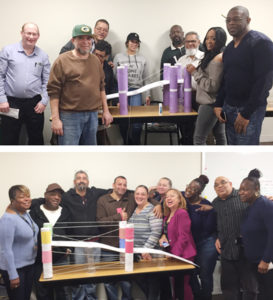As those of you who have attended our Certified Manager of Housing, Certified Manager of Maintenance, or Certified Financial Specialist program can attest, at NCHM we love using team participation exercises in our classroom training. The exercises vary but they all have two things in common: they are intended to help reinforce the concepts we teach, and they are almost always the highlight of the program.

Staff from the New York City Housing Authority show off their construction projects.
During a recent Supervisory and Leadership training program for staff of the New York City Housing Authority (NYCHA), we used an exercise we haven’t employed in over 30 years, and the results were nothing short of amazing.
In the exercise, the participants were divided into two teams of eight and nine people. A leader was appointed for each team. The teams were tasked with building a bridge out of materials supplied by the instructor. They were also given a set of specifications and some basic rules to follow. Each team was responsible for building one half of the bridge. A key specification was that the two halves had to meet in the middle. So, it was both a competition and a collaboration. The winner would be judged on both the functionality of the bridge and its “curb appeal.” The teams were given only an hour to accomplish the task and were not allowed to use any materials or tools other than those provided by the instructor.
Once time was up the bridge was tested using five toy cars and trucks of various weights and sizes. I’m pleased to say that both spans of the bridge supported the weight of the vehicles – but the true test was whether the cars and trucks would safely roll down the spans without incident. There were some tense moments and, in the end, one span went five for five, while the other saw two vehicles careen off the side due to a bump in the road. (Hint to future groups: don’t use too much tape to hold the roadway together!)
Everyone had a great time but it was the learning from the exercise that took center stage.
For example, after the exercise we introduced the “Five Practices of Exemplary Leadership” outlined in the outstanding bestseller, The Truth About Leadership, by James M. Kouzes and Barry Z. Posner:
- Model the Way
- Inspire a Shared Vision
- Challenge the Process
- Enable Others to Act
- Encourage the Heart
We discussed how the leaders of each team, without realizing it, had relied on these practices to accomplish the goal of building the bridge. Much of the discussion centered on how having a clear objective (building the bridge) enabled the leaders to “inspire a shared vision.” We also discussed how the leaders were able to “enable others to act” in part because there was a need to rely upon different skill sets to get the task accomplished. This meant that the leaders needed to quickly discover the talents of each member (some were good at design and engineering, others at construction, and still others at decorating) and blend those talents into a cohesive whole. We discussed how obstacles such as the inadequacy of resources and tools were overcome (“challenge the process”), how the leaders encouraged and praised team members as innovative ideas were brought forward (“encourage the heart”), and how the two team leaders didn’t just act as the “big boss,” but rather pitched in to help get the job done (“model the way”).
Virtually all participants thought the exercise was one of the most worthwhile two hours they had ever spent in a training program. It was fun and it was educational. Most importantly, the application of the bridge-building experience to the back-home reality of managing multifamily housing was easy for all to see. The same principles that made the bridge a success are the principles needed to create successful properties. Managers, whether they are at the site level or the executive level, whether they oversee property management, maintenance, or another function, are leaders by definition. They often don’t think of themselves that way, but they should, because the quality of their leadership has a direct impact on the quality of the property they manage.
It was a powerful learning experience – all from the simple act of building a paper bridge.
